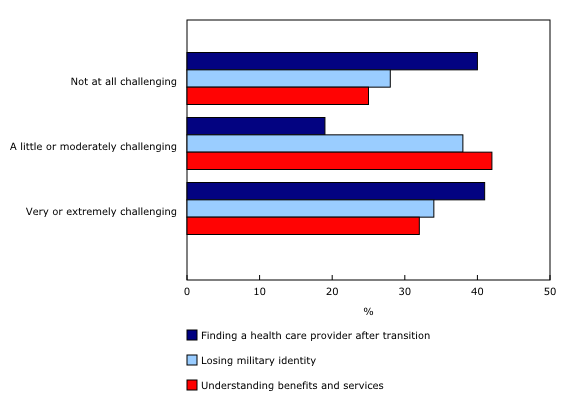Canadian Armed Forces Transition and Well-being Survey, 2016
Archived Content
Information identified as archived is provided for reference, research or recordkeeping purposes. It is not subject to the Government of Canada Web Standards and has not been altered or updated since it was archived. Please "contact us" to request a format other than those available.
Released: 2018-03-14
Each year, over 4,500 Canadian Armed Forces Regular Force members transition from military to civilian life. According to the Canadian Armed Forces Transition and Well-being Survey (CAFTWS), the transition experience varied among Regular Force members who were released in 2016. The CAFTWS was designed to provide a better understanding of the transition experiences of recently released Regular Force members and their families, including participating spouses or partners.
More than two-fifths (44%) of recently released members reported their adjustment to civilian life was very or moderately easy. More than a third (38%) said it was very or moderately difficult, while 18% said it was neither difficult nor easy.
Finding a health care provider after transition, losing their military identity, and understanding the benefits and services available to them and their families were cited as very or extremely challenging by at least a third of recently released members. At the same time, at least one in four members said these areas were not at all challenging, illustrating just how varied the transition experience can be for Regular Force members.
Many of the members who were recently released from the forces were still participating in the labour market. When asked about their current employment status, 36% said they had returned to work either full-time, 8% had returned to work part-time, 4% were self-employed, and close to 9% were unemployed and looking for work. A number of members (15%) said they had retired, while 14% said they were in school full-time and 14% said they were not in the workforce.
Spouses or partners living with recently released members were also asked about their transition experiences. The experiences frequently cited by them as very or extremely challenging were understanding the benefits and services available to them, and finding a health care provider after transition. Spouses or partners (35%) were less likely than the members (41%) to find themselves very or extremely challenged by finding a health care provider.
Nearly 6 in 10 (59%) spouses or partners of recently released members said they were working full-time, while 8% said they worked part-time and close to 6% were self-employed. About 4% were unemployed and looking for work, 10% were retired, 12% were not in the workforce and 1% said they were in school full-time.
Note to readers
The Canadian Armed Forces Transition and Well-being Survey was conducted by Statistics Canada on behalf of the Department of National Defence. This survey provides information to help develop a better understanding of the transition from military to civilian life, as well as to provide information to help improve programs and services offered to transitioning members and their families. The survey includes Regular Force members with two or more years of service who were released in 2016, as well as participating spouses or partners.
Contact information
For additional information regarding the Canadian Armed Forces Transition and Well-being Survey and for media enquiries, contact: Media Relations Department of National Defence (613-996-2353; mlo-blm@forces.gc.ca).
For more information about the concepts, methods or data quality of this release, contact Client Services, Special Surveys Division (toll-free 1-800-461-9050; 613-951-3321; fax: 613-951-4527; ssd@statcan.gc.ca).
- Date modified:


